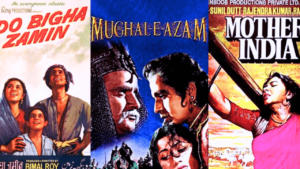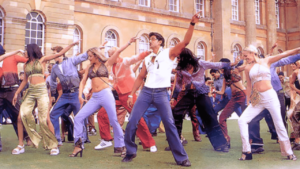Introduction
Bollywood, the heart of Indian cinema, is a vibrant and dynamic industry known for its colorful, high-energy films. Originating from the bustling city of Mumbai, Bollywood produces more films annually than Hollywood, making it one of the largest film industries in the world. Let’s explore Bollywood’s rich history, cultural influence, and global impact.
A Brief History of Bollywood
Bollywood’s journey began in the early 20th century with the release of India’s first silent film, Raja Harishchandra, directed by Dadasaheb Phalke in 1913. It ushered in a new era in Indian entertainment. By the 1930s, the industry had transitioned to sound films, with Alam Ara being the first Indian talkie. The 1950s and 1960s are often referred to as Bollywood’s “golden age,” with directors like Raj Kapoor, Guru Dutt, and Bimal Roy creating groundbreaking films that are still remembered today.
Evolution of Bollywood Cinema
Bollywood has evolved considerably over the past few decades, keeping pace with changing tastes and technology. The 1970s saw the rise of the “masala film” genre, which blended action, comedy, romance and drama. This era also brought legendary actors like Amitabh Bachchan, whose roles in films like Zanjeer and Sholay established him as a superstar.
The 1990s brought a new wave of filmmakers who introduced new stories and advanced production techniques. Directors like Yash Chopra and Karan Johar created romantic dramas that became cultural phenomena, while films like Dilwale Dulhania Le Jayenge set new standards for storytelling and box office success.
Iconic Bollywood films and their influence
Bollywood films have a unique way of attracting audiences both in India and abroad. Films like Mother India, Mughal-e-Azam and Lagaan are not only commercially successful, but are also cultural milestones that reflect the socio-political landscape of their times. These films have won numerous awards, including international ones, highlighting Bollywood’s global appeal.
Mother India (1957) is a classic film that depicts the struggle and resilience of Indian women, becoming a symbol of national pride. Mughal-e-Azam (1960) is renowned for its grandeur and epic story, while Lagaan (2001) brought Bollywood international recognition, earning an Academy Award nomination for Best Foreign Language Film.
Bollywood’s cultural influence
Bollywood’s influence extends beyond cinema, into various aspects of Indian culture. From fashion and music to dance and language, Bollywood shapes trends and sets standards. Iconic songs and dance sequences from Bollywood films are often reprised at weddings, festivals and social gatherings, reflecting the industry’s widespread cultural imprint.
Bollywood has also played an important role in promoting Indian culture globally. Indian diaspora communities around the world celebrate their heritage through Bollywood films, fostering a sense of unity and pride. In addition, Bollywood stars such as Shah Rukh Khan, Priyanka Chopra and Deepika Padukone have achieved international fame, bridging cultural gaps and expanding Bollywood’s reach.
The Modern Age of Bollywood
Today’s Bollywood is a blend of tradition and innovation. Filmmakers are experimenting with new genres, themes and storytelling techniques. There is a growing emphasis on content-driven cinema, with films such as Gully Boy, Article 15 and Andhadhun receiving critical acclaim for their bold storylines and powerful performances.
The digital revolution has also transformed Bollywood, with streaming platforms such as Netflix and Amazon Prime providing filmmakers with new avenues to reach global audiences. This shift has led to the production of high-quality web series and films that cater to different tastes and preferences.
The Economic Impact of Bollywood
Bollywood is not only an artistic endeavor but also a significant economic force. The industry contributes significantly to India’s economy, generating employment for millions of people, from actors and directors to technicians and support staff. Bollywood’s box office revenue, merchandising, and international distribution deals play a key role in its financial success.
The industry’s success has also fueled the growth of related sectors such as tourism and fashion. Bollywood-themed tours and events attract tourists from around the world, while Bollywood-inspired fashion trends influence designers and consumers alike.
Challenges and the way forward
Despite its success, Bollywood continues to face many challenges. Issues such as nepotism, lack of diversity, and gender inequality have sparked debate within the industry. However, there is growing awareness and efforts to address these concerns. Initiatives promoting diversity and inclusion are gaining momentum, and more women are taking on leading roles both in front of and behind the camera.
The future of Bollywood looks promising, as a new generation of filmmakers and actors are set to take the industry to greater heights. As Bollywood continues to evolve, it remains a powerful medium for storytelling, cultural expression, and global influence.
The Role of Music in Bollywood
Music is an integral part of Bollywood, enhancing the emotional and narrative aspects of films. Bollywood songs often outlive the films from which they originate, and become hits in their own right. The industry has produced legendary composers, singers and lyricists such as R.D. Burman, Lata Mangeshkar, Kishore Kumar and A.R. Rahman, whose contributions have shaped India’s music landscape.
Soundtracks and influences: Bollywood soundtracks are diverse, blending traditional Indian music with contemporary styles. Songs from Bollywood films are played at social events, religious ceremonies and parties, making them an important part of Indian cultural life. The popularity of Bollywood music has also led to collaborations with international artists, further increasing its global appeal.
Bollywood dance and choreography
Dance is another cornerstone of Bollywood, with elaborate dance sequences that blend various styles, including classical Indian dance, folk and modern dance forms. Choreographers such as Saroj Khan, Farah Khan and Prabhu Deva have created iconic dance sequences that are as memorable as the films themselves.
Dance and Cultural Significance: Bollywood dance shows often reflect traditional Indian celebrations and rituals, serving as a cultural bridge for audiences unfamiliar with Indian customs. Dance competitions and shows inspired by Bollywood choreography are popular around the world, highlighting the universal appeal of Bollywood’s dance culture.
Bollywood Stars and Their Influence
Bollywood actors and actresses enjoy immense popularity and influence in India and internationally. Stars such as Amitabh Bachchan, Shah Rukh Khan, Aishwarya Rai and Priyanka Chopra are known for their versatility and charisma.
Celebrity Influence: Bollywood stars often use their platform to advocate for social causes, influence public opinion and bring about social change. Their endorsement of brands and involvement in philanthropic activities further cement their status as influential individuals in society.
The Future of Bollywood
The future of Bollywood looks bright, with continued innovation and expansion on the horizon. Technological advancements, such as virtual reality and artificial intelligence, are set to revolutionise filmmaking and viewing experiences. Furthermore, the growing presence of women and diverse voices in the industry promises to bring new perspectives and stories.
Global collaborations: Bollywood is increasingly collaborating with international studios and filmmakers, leading to cross-cultural projects that appeal to a wider audience. This trend is expected to grow, further strengthening Bollywood’s position as a global entertainment force.
Sustainability and social responsibility: The industry is also becoming more aware of its environmental and social impact. Sustainable filmmaking practices and socially responsible storytelling are on the rise, reflecting a commitment to positive change.
Conclusion
Bollywood is not just an entertainment industry; it is a cultural phenomenon that unites millions through its films, music and stars. Its rich history, evolving narratives and global influence make it a unique and powerful force in the world of cinema. As Bollywood continues to innovate and adapt, it remains a testament to the creativity and resilience of Indian filmmakers and artists.
You might like this also :
Mumbai: Festivals That Bring the City to Celebrations 2024


